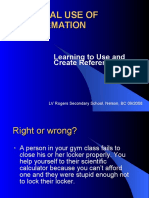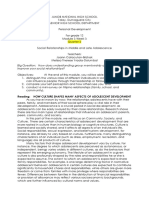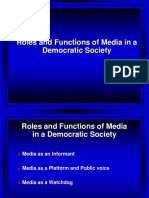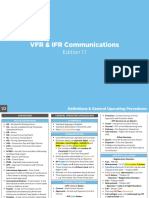0 ratings0% found this document useful (0 votes)
103 viewsReviewer
Reviewer
Uploaded by
jayson ayaayThis document contains a reviewer for media and information literacy with 45 multiple choice questions covering various topics related to media and information literacy including different types of media, assessing information accuracy and reliability, understanding media convergence, and the importance of developing critical thinking skills in the modern world.
Copyright:
© All Rights Reserved
Available Formats
Download as DOCX, PDF, TXT or read online from Scribd
Reviewer
Reviewer
Uploaded by
jayson ayaay0 ratings0% found this document useful (0 votes)
103 views3 pagesThis document contains a reviewer for media and information literacy with 45 multiple choice questions covering various topics related to media and information literacy including different types of media, assessing information accuracy and reliability, understanding media convergence, and the importance of developing critical thinking skills in the modern world.
Original Title
reviewer
Copyright
© © All Rights Reserved
Available Formats
DOCX, PDF, TXT or read online from Scribd
Share this document
Did you find this document useful?
Is this content inappropriate?
This document contains a reviewer for media and information literacy with 45 multiple choice questions covering various topics related to media and information literacy including different types of media, assessing information accuracy and reliability, understanding media convergence, and the importance of developing critical thinking skills in the modern world.
Copyright:
© All Rights Reserved
Available Formats
Download as DOCX, PDF, TXT or read online from Scribd
Download as docx, pdf, or txt
0 ratings0% found this document useful (0 votes)
103 views3 pagesReviewer
Reviewer
Uploaded by
jayson ayaayThis document contains a reviewer for media and information literacy with 45 multiple choice questions covering various topics related to media and information literacy including different types of media, assessing information accuracy and reliability, understanding media convergence, and the importance of developing critical thinking skills in the modern world.
Copyright:
© All Rights Reserved
Available Formats
Download as DOCX, PDF, TXT or read online from Scribd
Download as docx, pdf, or txt
You are on page 1of 3
Republic of the Philippines
Department of Education
Region IV – A CALABARZONS
Division of Quezon
CABAY NATIONAL HIGH SCHOOL
Tiaong, Quezon
REVIEWER IN MEDIA ANDINFORMATION LITERACY
NAME:_____________________________________________DATE:____________________ Grade 12
Choose the letter of the best answer and write it on a separate sheet of paper.
1. It is the physical objects used to communicate with, or the mass communication through physical objects such as radio,
television, computers, film, etc.
a. information b. literacy c. media d. media literacy
2. The ability of an individual, either working independently or with others, to responsibly, appropriately, and effectively use
technological tools.
a. information literacy b. media literacy c. technology literacy
3. The ability to access, analyze, evaluate, and create media in a variety of forms.
a. information literacy b. media literacy c. technology literacy d. media
4. The essential skills and competencies that allow individuals to engage with media and other information providers
effectively.
a. information literacy b. media literacy c. technology literacy d. media
5. The ability to recognize when information is needed, and to locate, evaluate, and effectively communicate information in its
various formats.
a. information literacy b. media literacy c. technology literacy d. media
6. The ability to identify, understand, interpret, create, communicate and compute, using printed and written materials
associated with varying contexts.
a. information b. literacy c. media d. media information
7. A broad term that covers processed data, knowledge derived from study, experience, instruction, signals or symbols.
a. information b. literacy c. media d. media information
8. An example of media and information during Electronic Age.
a. Cave paintings b. Television c. Typewriter d. radio
9. An example of media and information during Industrial Age.
a. Cave paintings b. Television c. Typewriter d. radio
10. An example of media and information during Pre-Industrial Age.
a. Cave paintings b. Television c. Typewriter d. radio
11. An example of media and information during Information Age.
a. blogs b. Television c. telegraph d. cave painting
12. An example of media and information during Information Age.
a. Cave paintings b. Social networks c. telegraph d. vlog
13. The co-existence of print media, broadcast media (radio and television), the Internet, mobile phones.
a. Broadcast Media b. New Media c. Media Convergence d. media information
14. The co-existence of traditional and new media.
a. Broadcast Media b. New Media c. Media Convergence d. media information
15. A media such as radio and television that reach target audiences using airwaves as the transmission medium.
a. Broadcast Media b. New Media c. Media Convergence d. media information
16. A media consisting of paper and ink, reproduced in a printing process that is traditionally mechanical.
a. Broadcast Media b. New Media c. Media Convergence d. media information
17. A content organized and distributed on digital platforms.
a. Broadcast Media b. New Media c. Media Convergence d. media information
18. It refers to the quality of information which can be verified and evaluated:
a. value b. timeliness c. accuracy d. reliability
19. Forecast is almost the same as the actual data. The information is said to be:
a. valuable b. accurate c. reliable d. timely
20. DOH pushes guidelines to avoid the spread of COVID – 19. Many of the families followed the guidelines and helped them
avoid the virus. The information from DOH shows:
a. timeliness b. reliability c. value d. accuracy
21. It refers to the period at which an information is published:
a. authority b. timeliness c. accuracy d. value
22. Which of the following source of information has the highest reliability?
a. library b. internet c. gossips d. blogs
23. Facebook, Twitter, and Instagram belongs to which alternative media?
a. blogs b. magazines c. social media d. flash mob
24. It refers to transmission of information through local channels:
a. indigenous knowledge b. indigenous communication c. indigenous media d. indigenous information
25. What will happen to educational programs if indigenous media are ignored?
a. not accessible b. irrelevant c. expensive d. boring
26. Which of the following is not a source of indigenous media?
a. folk media b. gatherings c. libraries d. oral instruction
27. Which of the following can be written, carved or oral?
a. records b. folk media c. gatherings d. direct observation
28. Which of the following is NOT an example of modern wearable technology?
a. Smart Watches b. Fitness Trackers c. Smartphones d. Headsets
29.Technology that takes advantage of the user’s sense of touch using computer applications
a. Contextual awareness b. Haptics c. VR Technology d. Wearable Technology
30. It refers to the model for delivering content online to any person who wants to take a course with no limit to attendance.
a. Education Model b. Model of Online Learning c. Massive Open Online Course d. Electronic Learning Model
31. Refers to a type of learning that happens anytime, anywhere and with anyone.
a. Global Learning b. Online Learning c. Ubiquitous Learning d. Virtual Learning
32. A technology that provides a big picture of learning outcomes through available data such as test results.
a. Analytics b. Learning trackers c. Online exams d. All of the above
33. DZMM, DZBB, DZME, DZRH and RADYO PATROL are examples of?
a. Print media b. Broadcast Media a c. Film d. New Media
34. An act or instance of using or closely imitating the language and thoughts of an author.
a. Copyrighting b. plagiarism c. net addiction d. cyber bullying
35. Which of the following is the global system of interconnected computer networks that uses the internet protocol suite to
communicate between networks and devices?
a. Media b. Information c. social media d. Internet
36. How did Facebook changed our lives in a good way?
a. We care less about our privacy.
b. Facebook changed the definition of friend.
c.Facebook has created online jobs and opportunities.
d. Facebook created negative effects on culture as well as in society.
37. Which of the following is considered as a positive use of media and information?
A. Use social media to complain or vent frustrations
b. Announce when you’re on holiday (and leaving your home empty
c. Express concerns about others, even if you think you are anonymous
d. Communicate positively, not negatively.
38. Which of the following is not included in considering information ACCURACY?
a. content must be grammatically correct
b. Sources and references must be cited.
c. Does tone and style implied properly.
d. Author’s name is easily visible
39. Is it possible that different individual derives a different meaning from the message?
a. Yes, because he or she is coming from a different point of view and/or background.
b. Yes , because sometimes information is unclear.
c. Yes, because most of the time people don’t want to understand.
d. Yes , because strategies in understanding were not introduced
40. It is a form of electronic communication through which people create online communities.
a. Mass media b. New Media c. Transmedia d. Social Media
41. A media and information literate individual is someone who:
a. thinks critically b. thinks irrationally c. thinks unethically d. thinks immorally
42. What organization cites the importance of media and information literacy in the modern world?
a. UNESCO b. Media Quest Holdings c. Press Alliance d. Foundation for Media Alternatives
43. Video Games can also be considered as type of media. Why is it possible?
a. Because it affects human behavior like social media did.
b. Because it’s been a means in which people are entertained.
c. Because video games has features that enable communication.
d. Because Millennials must be in a trend.
44. a visual design principle that brings together a composition with similar units
a. balance b. contrast c. harmony d. organize
45. the visual flow of a composition
a. directional movement b. perspective c. rhythmic pattern d. organize
46. a shot where the subject is framed from shoulders up
a. close up b. extreme close up c. medium close up d. full shot
47. a shot perfect to show the world where the story takes place
a. extreme wide shot b. full shot c. long shot d. close up
48. another term for Dutch angle
a. canted shot b. over the shoulder shot c. worm’s eye view d. extreme shot
49. a camera angle that makes a subject look powerful and imposing
a. eye level b. high angle c. low angle d. full shot
50. a shot taken from an elevated point
a. bird’s eye view b. Dutch angle e c. eye level d. low angle
REVIWER IN MEDIA AND INFORMATION LITERACY
NAME:_____________________________________________DATE:____________________ Grade 12
AB C DE
You might also like
- Week 1 MilDocument3 pagesWeek 1 MilJodimar Lee BadiolaNo ratings yet
- Media and SocietyDocument10 pagesMedia and SocietyMohan Krishna SuggunaNo ratings yet
- Too Low An SWR Can Kill YouDocument12 pagesToo Low An SWR Can Kill Youcarl_lavoie_1973No ratings yet
- Dashcam 70mai Pro User GuideDocument1 pageDashcam 70mai Pro User GuideFauzan FasnidNo ratings yet
- 4th Summative-2Document5 pages4th Summative-2Loreen RoaNo ratings yet
- 6 Media and Information SourcesDocument10 pages6 Media and Information SourcesLiecky Jan BallesterosNo ratings yet
- MIL 1Q Unified ExaminationDocument4 pagesMIL 1Q Unified ExaminationMaria Rizza LuchavezNo ratings yet
- Ict 101 Media Types ConvergenceDocument9 pagesIct 101 Media Types ConvergenceSa JeesNo ratings yet
- Colegio San Agustin-Mati, Inc.: Teaching GuideDocument17 pagesColegio San Agustin-Mati, Inc.: Teaching GuideGonzalo balusca100% (1)
- Test 2Document2 pagesTest 2Jose Nilo PastorallNo ratings yet
- 1st Quarter Examination in Media and Information LiteracyDocument2 pages1st Quarter Examination in Media and Information LiteracyWinnie Mae L. GasparNo ratings yet
- SHS12-Trends-Q1W3 To Q1W4 NEWDocument12 pagesSHS12-Trends-Q1W3 To Q1W4 NEWPaige Jan DaltonNo ratings yet
- Grade 12 - Media and Information Literacy - Q1 - W6Document5 pagesGrade 12 - Media and Information Literacy - Q1 - W6White SilenceNo ratings yet
- 3is ModuleDocument9 pages3is ModuleJessaMae Albaracin100% (1)
- SUMMATIVE EXAM MIL 3rd QuarterDocument3 pagesSUMMATIVE EXAM MIL 3rd QuarterMiss Kath GuillermoNo ratings yet
- MIL SummativeDocument1 pageMIL SummativeMira Lei MarigmenNo ratings yet
- MIL Quarter 1 Module 2Document12 pagesMIL Quarter 1 Module 2Mikhaila Fernandez100% (1)
- Mil ReviewerDocument2 pagesMil ReviewerHershey Eve100% (1)
- SHS MIL Q4 Weeks1to4 Binded Ver1.0Document41 pagesSHS MIL Q4 Weeks1to4 Binded Ver1.0Jennica LopenaNo ratings yet
- Inquiry Immersion Module 1 Week 9Document16 pagesInquiry Immersion Module 1 Week 9jonah escañoNo ratings yet
- 3is Q4 Week 5Document10 pages3is Q4 Week 5Joanna Mae DelicanaNo ratings yet
- Module 4 Lesson 1Document12 pagesModule 4 Lesson 1BenNo ratings yet
- MIL - Week 1Document21 pagesMIL - Week 1Aira Manuba MozoNo ratings yet
- What Is Media LiteracyDocument2 pagesWhat Is Media LiteracyJohn Paul MartinNo ratings yet
- Mil WK 5 AssessmentDocument2 pagesMil WK 5 AssessmentClarita EddioNo ratings yet
- Midterm Exam SY 2022-2023 in MILDocument3 pagesMidterm Exam SY 2022-2023 in MILLicht 2.0No ratings yet
- Media & Information Literacy First Grading Reviewer Introduction To Media & Information LiteracyDocument3 pagesMedia & Information Literacy First Grading Reviewer Introduction To Media & Information LiteracySid TuazonNo ratings yet
- MIL Final ExaminationDocument2 pagesMIL Final ExaminationJhoel Kenneth GulleNo ratings yet
- PhilosophyDocument7 pagesPhilosophyRb Renbran ParrillaNo ratings yet
- Ethical Use of InformationDocument32 pagesEthical Use of InformationKat CaladoNo ratings yet
- Summative Test MilDocument2 pagesSummative Test MilJarven SaguinNo ratings yet
- 4 Social Relationships in Middle and Late Adolescence PerDev Week 4 Module 3 Q2Document8 pages4 Social Relationships in Middle and Late Adolescence PerDev Week 4 Module 3 Q2Angel TubatNo ratings yet
- Topic/Lesson Name Content Standards Performance Standards Learning CompetenciesDocument8 pagesTopic/Lesson Name Content Standards Performance Standards Learning Competenciesrhiantics_kram11No ratings yet
- Media and Information Literacy (MIL) - Lesson Exemplar 4Document11 pagesMedia and Information Literacy (MIL) - Lesson Exemplar 4robejr2013No ratings yet
- Selecting Citing and Synthesizing Related LiteratureDocument19 pagesSelecting Citing and Synthesizing Related LiteratureCloud Stephen JindaniNo ratings yet
- Eapp ModuleDocument22 pagesEapp ModuleJoan MinaNo ratings yet
- Normative Theory: The Four Theories of The Press/MediaDocument27 pagesNormative Theory: The Four Theories of The Press/MediaMaria Jenina CervantesNo ratings yet
- Media and Information Literacy (MIL) - Lesson Exemplar 2Document14 pagesMedia and Information Literacy (MIL) - Lesson Exemplar 2robejr2013100% (1)
- Learning Module 4: Oral CommunicationDocument8 pagesLearning Module 4: Oral CommunicationKobe BryNo ratings yet
- Interactive FOR Media Information LiteracyDocument7 pagesInteractive FOR Media Information LiteracyJoel Cabusao Lacay100% (1)
- Week 10 EditedDocument8 pagesWeek 10 EditedAlva RedoñaNo ratings yet
- 7 The Power of Media and InformationDocument28 pages7 The Power of Media and InformationFluffy CliffyNo ratings yet
- Empowerment Tech.Q1 - Mod3 1, 9 - 33Document39 pagesEmpowerment Tech.Q1 - Mod3 1, 9 - 33Paul VergaraNo ratings yet
- Media and Information LiteracyDocument20 pagesMedia and Information LiteracyEicelle Rein ParumogNo ratings yet
- Sdoquezon Adm SHS12 C Mil M5Document20 pagesSdoquezon Adm SHS12 C Mil M5Gabrelle OgayonNo ratings yet
- Media and Information LiteracyDocument9 pagesMedia and Information LiteracyJoi BarlisNo ratings yet
- Roles and Functions of Media in A Democratic SocietyDocument15 pagesRoles and Functions of Media in A Democratic SocietyCelia VitoNo ratings yet
- BLUE Media Information Literacy G12 2nd Q Exam With Answer KeyDocument5 pagesBLUE Media Information Literacy G12 2nd Q Exam With Answer KeyJose Lim Jr.No ratings yet
- Media and Informatio N SourcesDocument13 pagesMedia and Informatio N SourcesJennieca TablarinNo ratings yet
- V5 Empowerment Technologies WHLP, Summative Assessments, Performance TasksDocument6 pagesV5 Empowerment Technologies WHLP, Summative Assessments, Performance TasksMoira Abesmo100% (1)
- An Introduction To Mil: Maria Lourdes G. Coronacion LSHS Teacher SY 2018-2019Document28 pagesAn Introduction To Mil: Maria Lourdes G. Coronacion LSHS Teacher SY 2018-2019petor fiegelNo ratings yet
- SHS CW Q2 Module1 WK2Document12 pagesSHS CW Q2 Module1 WK2Ma rosario JaictinNo ratings yet
- Media & Information Tech. Lesson 1Document2 pagesMedia & Information Tech. Lesson 1Dolly RizaldoNo ratings yet
- Summative in MIL 3Q-M1 QuestionnairesDocument2 pagesSummative in MIL 3Q-M1 QuestionnairesRon AblanidaNo ratings yet
- A MIL Q1M8 Teacher Copy FinalDocument22 pagesA MIL Q1M8 Teacher Copy FinalIvy BarnacheaNo ratings yet
- Media and Information Literacy Week 3Document12 pagesMedia and Information Literacy Week 3Fritz Lucky Dela CruzNo ratings yet
- Mil q2 3rd Summative TestDocument3 pagesMil q2 3rd Summative TestrosellerNo ratings yet
- MIL Idea Exemplar-Week 3Document6 pagesMIL Idea Exemplar-Week 3CyrelOcfemiaNo ratings yet
- Media and Information Literacy LAS Quarter 1Document13 pagesMedia and Information Literacy LAS Quarter 1Glaiza ValentinoNo ratings yet
- Module 1 - MilDocument8 pagesModule 1 - MilJhondel MorongNo ratings yet
- Introduction To Media and Information LiteracyDocument30 pagesIntroduction To Media and Information LiteracyStep OlivaNo ratings yet
- Lesson ExemplarDocument5 pagesLesson Exemplarjayson ayaayNo ratings yet
- 2nd Quarter Exam MilDocument3 pages2nd Quarter Exam Miljayson ayaay100% (1)
- Mil TosDocument3 pagesMil Tosjayson ayaayNo ratings yet
- 2N Quarterly Exam in PhilosDocument2 pages2N Quarterly Exam in Philosjayson ayaayNo ratings yet
- Umts BasicsDocument156 pagesUmts BasicsNitin GuptaNo ratings yet
- Ebook Scientific InstrumentsDocument9 pagesEbook Scientific InstrumentsPavans LuckyNo ratings yet
- Codruta Pricop - GMDSS - GOCDocument283 pagesCodruta Pricop - GMDSS - GOCVizureanu Ionut100% (3)
- Radar (Microwave) MethodsDocument26 pagesRadar (Microwave) MethodsAjay CongoNo ratings yet
- B787B1B2 - ATA23 - (10 Differences) - R1Document5 pagesB787B1B2 - ATA23 - (10 Differences) - R1AlejandroNo ratings yet
- Radio/Navigation System (RNS) With Multi-Function Display (MFD) and TVDocument24 pagesRadio/Navigation System (RNS) With Multi-Function Display (MFD) and TVFlorian LeordeanuNo ratings yet
- MCQ BroadcastingDocument50 pagesMCQ BroadcastingLorenz Ardiente100% (5)
- CQ Amateur Radio - November 2021Document116 pagesCQ Amateur Radio - November 2021SergioMarcosMarascaNo ratings yet
- 2015 Diamond CatalogDocument32 pages2015 Diamond Catalogpap_ingos100% (1)
- Telecom: U. B. DesaiDocument30 pagesTelecom: U. B. DesaiNitin KumarNo ratings yet
- Antenna L InEDocument2 pagesAntenna L InERasheed Yaser RabahNo ratings yet
- Steren Ant HD 040 InstrDocument14 pagesSteren Ant HD 040 InstrfacshionNo ratings yet
- Theoretical Comparison of Direct-Sampling Versus Heterodyne RF Receivers - IEEE Journals & MagazineDocument2 pagesTheoretical Comparison of Direct-Sampling Versus Heterodyne RF Receivers - IEEE Journals & MagazineEnricoLia0% (1)
- Airband Squelch Silicon Chip Magazine 2008-12 Dec 0056Document3 pagesAirband Squelch Silicon Chip Magazine 2008-12 Dec 0056Alex NascimentoNo ratings yet
- 3 Tactics For Configuring Phase-Coherent RF Signal GenerationDocument13 pages3 Tactics For Configuring Phase-Coherent RF Signal GenerationAntonio GeorgeNo ratings yet
- 7050 XXXDocument1 page7050 XXXJohn DoeNo ratings yet
- FM Radio Listener Ship in TrichurDocument134 pagesFM Radio Listener Ship in TrichurNicy Prethew100% (1)
- Universal Radio Hacker: A Suite For Analyzing and Attacking Stateful Wireless ProtocolsDocument14 pagesUniversal Radio Hacker: A Suite For Analyzing and Attacking Stateful Wireless ProtocolsMarwane TassaNo ratings yet
- SST Disaster Management ProjectDocument5 pagesSST Disaster Management Projectskull face 151No ratings yet
- Quiz 1 SolutionDocument4 pagesQuiz 1 SolutionMei QiiNo ratings yet
- Principles of Communications: Bessel FunctionDocument21 pagesPrinciples of Communications: Bessel FunctionJames Matthew WongNo ratings yet
- WiMAX TutorialDocument9 pagesWiMAX TutorialpathlossanwarNo ratings yet
- (Chapter 07) OFDM - Theory PDFDocument50 pages(Chapter 07) OFDM - Theory PDF01689373477No ratings yet
- VFR & IFR Comms - Keys NotesDocument7 pagesVFR & IFR Comms - Keys NotesESTHER MARÍA MARTÍN MARTÍNNo ratings yet
- Notebook PC User Manual G 60Document30 pagesNotebook PC User Manual G 60Ali KhanNo ratings yet
- Cs Tcom RF 7850m v50x Power Amplifier DatasheetDocument2 pagesCs Tcom RF 7850m v50x Power Amplifier DatasheetazizrakouchNo ratings yet
- CMC Unit VDocument47 pagesCMC Unit Veffective thinkerNo ratings yet




























































































